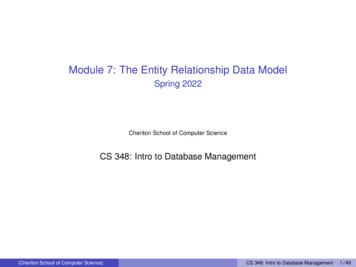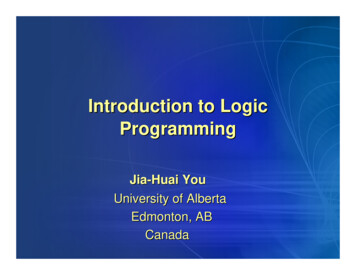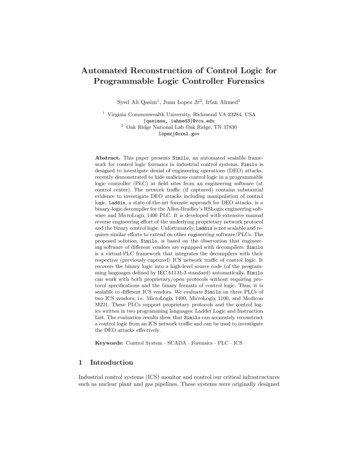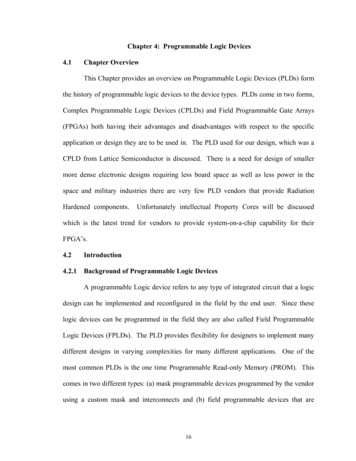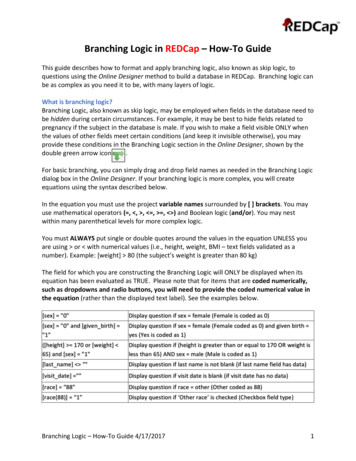
Transcription
CS245 Logic and ComputationAlice GaoJune 26, 2018Contents1 Propositional Logic1.1 Translations . . . . . . . . . . . . . . . . . . . . . . . . . . . .1.2 Structural Induction . . . . . . . . . . . . . . . . . . . . . . .1.3 Tautology, Contradiction, and Satisfiable but Not a Tautology1.4 Logical Equivalence . . . . . . . . . . . . . . . . . . . . . . . .1.5 Analyzing Conditional Code . . . . . . . . . . . . . . . . . . .1.6 Circuit Design . . . . . . . . . . . . . . . . . . . . . . . . . . .1.7 Semantic Entailment . . . . . . . . . . . . . . . . . . . . . . .1.8 Natural Deduction . . . . . . . . . . . . . . . . . . . . . . . .1.8.1 Strategies for writing a natural deduction proof . . . .1.8.2 And elimination and introduction . . . . . . . . . . . .1.8.3 Implication introduction and elimination . . . . . . . .1.8.4 Or elimination and introduction . . . . . . . . . . . . .1.8.5 Negation introduction and double negation elimination1.8.6 Negation elimination . . . . . . . . . . . . . . . . . . .1.8.7 Putting it together! . . . . . . . . . . . . . . . . . . . .1.8.8 Other problems . . . . . . . . . . . . . . . . . . . . . .1.9 Soundness and Completeness of Natural Deduction . . . . . .1.9.1 The soundness of inference rules . . . . . . . . . . . . .1.9.2 Soundness and Completeness of Natural Deduction . .33913141618232626272830323435383939412 Predicate Logic2.1 Translations . . . . . . . . . . . . . . . . . . . . . . . . . . .2.2 Semantics of Predicate Formulas . . . . . . . . . . . . . . .2.2.1 Evaluating Formulas with No Variables . . . . . . . .2.2.2 Evaluating Formulas with Free Variables Only . . . .2.2.3 Evaluating Formulas with Free and Bound Variables2.2.4 Evaluating Formulas with Bound Variables Only . .2.3 Semantic Entailment . . . . . . . . . . . . . . . . . . . . . .44445050525456601.
2.42.5Natural Deduction . . . . . . . . . . . . . . . . . . . . . . . .2.4.1 Forall-elimination . . . . . . . . . . . . . . . . . . . . .2.4.2 Exists-introduction . . . . . . . . . . . . . . . . . . . .2.4.3 Forall-introduction . . . . . . . . . . . . . . . . . . . .2.4.4 Exists-elimination . . . . . . . . . . . . . . . . . . . .2.4.5 Putting them together . . . . . . . . . . . . . . . . . .Soundness and Completeness of Natural Deduction . . . . . .2.5.1 Proving that an inference rule is sound or not sound .2.5.2 Proofs using the soundness and completeness theorems2.656666676869727276
1Propositional Logic1.1TranslationsExercise 1. Translate the following three sentences into propositional logic. Nadhi will eat a fruit if it is an apple. Nadhi will eat a fruit only if it is an apple. Nadhi will eat a fruit if and only if it is an apple.n: Nadhi will eat a fruit.a: The fruit is an apple. Nadhi will eat a fruit if it is an apple.Translation: (a n)If the fruit is an apple, we know that Nadhi will eat it.If the fruit is not an apple, Nadhi may or may not eat it.The set of apples is a subset of the set of fruits that Nadhi eats. Nadhi will eat a fruit only if it is an apple.Translation: (n a)If Nadhi eats a fruit, then we know that it is an apple.If Nadhi does not eat a fruit, the fruit may or may not be an apple.The set of fruits that Nadhi eats is a subset of the set of apples. Nadhi will eat a fruit if and only if it is an apple.Translation: (n a)If Nadhi eats a fruit, then it is an apple.If Nadhi does not eat a fruit, then it is not an apple.The set of fruits that Nadhi eats and the set of apples coincide.3
Exercise 2. Translate the following sentence into multiple propositional formulas. Showthat they are logically equivalent using a truth table.Soo-Jin will eat an apple or an orange but not both.a: Soo-Jin will eat an apple. o: Soo-Jin will eat an orange.This sentence translates into an exclusive OR. There are many ways of writing down aformula for an exclusive OR. ((a o) ( (a o)))a or o is true, but not both. ((a o) (( a) ( o)))a or o is true, and a is false or o is false. ((a ( o)) (( a) o))a is true and o is false, or a is false and o is true. ( (a o))It is not the case that a and o have the same truth value. (( a) o) (a ( o))negated a and o have the same truth value.4
Exercise 3. Translate the following sentence into at least three syntactically different propositional formulas. Show that they are logically equivalent using a truth table.If it is sunny tomorrow, then I will play golf, provided that I am relaxed. s: It is sunny tomorrow. g: I will play golf. r: I am relaxed.I can think of three ways of translating this sentence into a propositional formula. Interpretation 1: If it is sunny tomorrow, then, if I am relaxed, then I will play golf.Translation: (s (r g)).Sunny tomorrow is the premise for the first. Interpretation 2: If it is sunny tomorrow and I am relaxed, then I will play golf.Translation: ((s r) g).Sunny tomorrow and being relaxed together are premises for playing golf. Interpretation 3: If I am relaxed, then, if it is sunny tomorrow, I will play golf.Translation: (r (s g)).Being relaxed is the premise for the rest.All three interpretations are logically equivalent.5
Exercise 4. Translate the following sentence into a propositional formula.If I ace CS 245, I will get a job at Google; otherwise I will apply for the GeekSquad.Define the propositional variables: a: I ace CS 245. g: I will get a job at Google. s: I will apply for the Geek Squad.First, let’s break down this sentence into two parts by the semicolon.The first part translates into an implication because of the key word “if”. It becomes (a g).In the second part, “otherwise” means that “if I don’t ace CS 245”. After rephrasing, thesecond part becomes “If I don’t ace CS 245, then I will apply for the Geek Squad.” This isanother implication (( a) s).Now the tricky part is: what connective should we use to connect the two parts together?Two natural options are and . The option seems possible because the sentence couldbe rephrase as “If I ace CS 245, .; or otherwise .”The correct connective to use is for the following reasons.Let’s consider the scenario in which I ace CS 245, I don’t get a job at Google and I apply forthe Geek Squad. In this case, is the sentence true or false? Intuitively, the sentence shouldbe false, because the first implication is violated when I ace CS 245 but do not get a job atGoogle. Now let’s look at the truth values of the two possible propositional formulas: If we use as the connective, the resulting formula ((a g) (( a) s)) is falsein this scenario. The truth value of the formula is the same as the truth value of thesentence in this scenario. If we use as the connective, the resulting formula ((a g) (( a) s)) is true inthis scenario. This truth value of the formula is different from the truth value of thesentence in this scenario. Therefore, is not the correct connective to use because theresulting formula has a different meaning from the formula.6
Exercise 5. Translate the following sentence into two propositional formulas and prove thatthe formulas are not logically equivalent using a truth table.Sidney will carry an umbrella unless it is sunny.Define the propositional variables.u: Sidney will carry an umbrella.s: It is sunny. Interpretation 1:Intuitively, many people understand “unless” as an “exclusive OR”, which means thatexactly one of the two parts of the sentence is true at a time.With this interpretation, “unless” is equivalent to an “if and only if not”. The sentenceis true under the following two scenarios:– It is not sunny and Sidney carries an umbrella.– It is sunny and Sidney does not carry an umbrella.Note that this interpretation does not allow Sidney to carry an umbrella when it issunny. So the sentence is false when u and s are both true.In propositional logic, this is equivalent to(( u) s) (( u) s) (u ( s))) ((u s) ( (u s))) ((u s) (( u) ( s))).(1)(2)(3)(4)All the formulas above are equivalent. They look different but their meanings are thesame. Interpretation 2:Alternatively, you may think of “unless” as meaning “if not”. Then the sentencebecomes: if it is not sunny, then Sidney will carry an umbrella. In propositional logic,this becomes:(( s) u) (( ( s)) u) (s u).Under this interpretation, this sentence is true under three scenarios:– It is not sunny and Sidney carries an umbrella.7(5)(6)(7)
– It is sunny and Sidney does not carry an umbrella.– It is sunny and Sidney carries an umbrella.Notice that this interpretation allows Sidney to carry an umbrella when it is sunny. Sothe sentence is true when u and s are both true.8
1.2Structural InductionTheorem 1. Every well-formed formula has an equal number of opening and closing brackets.Proof by Structural Induction. Let P(φ) denote that the well-formed formula φ has an equalnumber of opening and closing brackets. Let op(φ) and cl(φ) denote the number of openingand closing brackets of φ respectively.Base case: φ is a propositional variable q. Prove that P(q) holds.q has zero opening and zero closing bracket. Thus, P(φ) holds.Induction step:Case 1: φ is ( a), where a is well-formed.Induction hypothesis: Assume that P(a) holds.We need to prove that P(( a)) holds.op(( a)) 1 op(a) 1 cl(a) By induction hypothesis cl(( a))(8)(9)(10)Thus, P(( a)) holds.Case 2: φ is (a b) where a and b are well-formed and is a binary connective.Induction hypothesis: Assume that P(a) and P(b) hold.We need to prove that P((a b)) holds.op((a b)) 1 op(a) op(b) 1 cl(a) cl(b) By induction hypothesis cl(a b)(11)(12)(13)Thus, P((a b)) holds.By the principle of structural induction, P(φ) holds for every well-formed formula φ.QED9
Theorem 2. Every proper prefix of a well-formed formula has more opening than closingbrackets.Proof by Structural Induction. Let P(φ) denote that every proper prefix of the well-formedformula φ has more opening than closing brackets.Let op(φ) and cl(φ) denote the number of opening and closing brackets of φ respectively.Base case: φ is a propositional variable q. Prove that P(q) holds.Induction step:Case 1: φ is ( a), where a is well-formed.Induction hypothesis: Assume that P(a) holds.We need to prove that P(( a)) holds.Let m denote any proper prefix of a. There are four possible proper prefixes of( a): (, ( , ( m, and ( a. We will prove the four cases separately.op(() 1cl(() 0op(() cl(()(14)(15)(16)op(( ) 1cl(( ) 0op(( ) cl(()(17)(18)(19)op(( m) 1 op(m) 1 cl(m) By the induction hypothesis on m cl(m) cl(( m)(20)(21)(22)(23)(24)op(( a) 1 op(a) 1 cl(a) By Theorem 1 and a is a well-formed formula cl(a) cl(( a)(25)(26)(27)(28)(29)10
Case 2: φ is (a b) where a and b are well-formed and is a binary connective.Let m and n denote any proper prefix of a and b respectively.Induction hypothesis: Assume that P(a) and P(b) hold. In other words, P(m)and P(n) are true.We need to prove that P((a b)) holds.There are six possible proper prefixes of (a b): (, (m, (a, (a , (a n, and (a b.op(() 1cl(() 0op(() cl(()(30)(31)(32)op((m) 1 op(m) 1 cl(m) By the induction hypothesis on m cl(m) cl((m)(33)(34)(35)(36)(37)op((a) 1 op(a) 1 cl(a) By Theorem 1 and a is a well-formed formula cl(a) cl((a)(38)(39)(40)(41)(42)op((a ) 1 op(a) 1 cl(a) By Theorem 1 and a is a well-formed formula cl(a) cl((a )(43)(44)(45)(46)(47)11
op((a n) 1 op(a) op(n) 1 cl(a) op(n) By Theorem 1 and a is a well-formed formula 1 cl(a) cl(n) By the induction hypothesis on n cl(a) cl(n) cl((a n)(48)(49)(50)(51)(52)(53)op((a b) 1 op(a) op(b) 1 cl(a) cl(b) By Theorem 1 and a is a well-formed formula cl(a) cl(b) cl((a b)(54)(55)(56)(57)(58)By the principle of structural induction, P(φ) holds for every well-formed formula φ.QED12
1.3Tautology, Contradiction, and Satisfiable but Not a TautologyExercise 6. Determine whether each of the following formulas is a tautology, satisfiable butnot a tautology, or a contradiction. pAnswer: Satisfiable but not a tautology.Reason: True when p is true and false when p is false. ((r s) r)Answer: Tautology.Reason: When r is true, the conclusion of the implication is true, so the implicationis true. When r is false, the premise of the implication is false, so the implication isvacuously true. (( (p q)) (q p))Answer: Satisfiable but not a tautologyReason: It’s tempting to say “these two formulas don’t mean the same thing so thebiconditional is false”. However, go back to truth values. When p is true and q is false,both sides of the biconditional are true and the biconditional itself is true. When pand q are both true, the left side is false but the right is true, and so the biconditionalis false. ((((p q) (p ( q))) (( p) q)) (( p) ( q)))Answer: ContradictionReason: The first half can be simplfiied to (p (q ( q))), which is (p F) or p. Thesecond half can be simplfiied to ( p). Thus, the entire formula is (p ( p)), which isa contradiction.13
1.4Logical EquivalenceExercise 7. ”If it is sunny, I will play golf, provided that I am relaxed.”s: it is sunny. g: I will play golf. r: I am relaxed.There are three possible translations:1. (r (s g))2. ((s r) g)3. (s (r g))Prove that all three translations are logically equivalent.Part 1: (r (s g)) ((s r) g).Proof.(r (s g)) (r (( s) g)) (( r) (( s) g)) ((( r) ( s)) g) ((( (r s)) g) ((r s) g) ((s r) g)ImplicationImplicationAssociativityDe 68)(69)(70)(71)(72)(73)Part 2: (r (s g)) (s (r g)).Proof.(r (s g)) (r (( s) g)) (( r) (( s) g)) ((( r) ( s)) g) ((( s) ( r)) g) (( s) (( r) g)) (( s) (r g)) (s (r g))14
Exercise 8. ”If it snows then I will not go to class but I will do my assignment.”s: it snows. c: I will go to class. a: I will do my assignment.There are two possible translations:1. ((s ( c)) a)2. (s (( c) a))Prove that the two translations are NOT logically equivalent.Proof. We need to find a valuation t under which the two formulas have different values.Consider the truth valuation t where t(s) F, t(c) T, and t(a) F.The two formulas have different values under t, as shown below. ((s ( c)) a)t F (s (( c) a))t T15
1.5Analyzing Conditional CodeConsider the following code fragment:if ( input 0 ! output ) {if (!( output && queuelength 100)) {P1} else if ( output && !( queuelength 100)) {P2} else {P3}} else {P4}Define the propositional variables: i: input 0 u: output q: queuelength 100The code fragment becomes the following. We’ll call this code fragment #1.if ( i !u ) {if ( !( u && q) ) {P1} else if ( u && !q ) {P2} else { P3 }} else { P4 }Code fragment #2:if (( i && u) && q) {P3} else if (!i && u) {P4} else {P1}Prove that these two pieces of code fragments are equivalent:16
Prove that the condition leading to P2 is logically equivalent to F.The condition leading to P2 :(((i ( u)) ( ( (u q)))) (u ( q))) (((i ( u)) (u q)) (u ( q))) ((i ( u)) ((u u) (q ( q)))) ((i ( u)) (u (q ( q)))) ((i ( u)) (u F)) ((i ( u)) F) FDouble NegationAssociativity, n 1Simplification 1(74)(75)(76)(77)(78)(79)(80)(81)Prove that the condition leading to P3 is true if and only if all three variables are true.The condition leading to P3 :(((i ( u)) (u q)) ( (u ( q)))) (((i ( u)) (u q)) (( u) ( ( q)))) (((i ( u)) (u q)) (( u) q)) ((i ( u)) (u (q (( u) q))))) ((i ( u)) (u q)) ((i ( u)) u) q) (((i u) (( u) u)) q) (((i u) F) q) ((i u) q)De MorganDouble NegationAssociativitySimplification ation 1(82)(83)(84)(85)(86)(87)(88)(89)(90)Prove that the condition leading to P4 is true if and only if i is false and u is true.The condition leading to P4 :( (i ( u)))(( i) ( ( u))) (( i) u)De MorganDouble Negation(91)(92)(93)The condition leading to P1 :((i ( u)) ( (u q))) ((i ( u)) (( u) ( q))) (( u) (i ( q)))17De MorganDistributivity(94)(95)(96)
1.6Circuit DesignBasic gates:Problem: Your instructors, Alice, Carmen, and Collin, are choosing questions to be put onthe midterm. For each problem, each instructor votes either yes or not. A question is chosenif it receives two or more yes votes. Design a circuit, which outputs yes whenever a questionis chosen.1. Draw the truth table based on the problem FFF2. Convert the truth table into a propositional formula.3. Then, convert the formula to a circuit.18
Solution 1:1. Convert the truth table into a propositional formula.Convert each row of the truth table to a conjunction.If a variable is true in that row, write it down. Otherwise, if the variable is false, writedown its negation. Then connect all variables or their negations together using AND. ((x y) z) ((x y) ( z)) ((x ( y)) z) ((( x) y) z)Connect all formulas into a disjunction.(((((x y) z) ((x y) ( z))) ((x ( y)) z)) ((( x) y) z))2. Draw the circuit.Making a circuit clear and readable can be challenging. Here are some advice ondrawing circuits: Determine where to put the inputs and the outputs first. Determine where to put the major gates (the OR at the end, and one AND foreach scenario). Try to draw wires horizontally or vertically, not at an angle. Indicate clearly whether two crossing wires are connected or not.19
Solution 2:1. Convert the truth table into a propositional formula.Converts rows 1-3 to a propositional formula.(x (y z))Convert row 5 to a propositional formula.((( x) y) z)Connect all formulas into a disjunction.((x (y z)) ((( x) y) z))2. Draw the circuit.20
Solution 3:1. Convert the truth table into a propositional formula.Convert rows 1 and 5 into a propositional formula.(y z)Convert rows 2 and 3 into a propositional formula.(x (y z))For convenience, we will use the symbol to represent an exclusive OR. However, youare only allowed to use this symbol in circuit design problems. You are not allowed touse this symbol for other problems because it is not a basic connective based on thedefinition of well-formed formulas.Connect all formulas into a disjunction.((y z) (x (y z)))2. Draw the circuit.21
Solution 4 (contributed by Triman Kandola)1. Convert the truth table into a propositional formula.(((x y) (x z)) (y z))This formula intuitively makes sense. If two people are already voting yes, then I don’tcare about what the third vote is.2. Draw the circuit.22
1.7Semantic EntailmentExercise 9. Let Σ {(p q), (q r)}. Is Σ satisfiable? Why or why not?Σ is satisfied by the truth valuation t where t(p) T, t(q) T and t(r) T.Note that (p q)t T and (q r)t T. Thus, Σ is satisfiable.Exercise 10. Let Σ . Is Σ satisfiable? Why or why not?Σ is satisfiable. In fact, any truth valuation satisfies Σ.A truth valuation t satisfies Σ if and only if, for any formula α, if α is in Σ, then αt T.Since Σ , no formula is in Σ. The premise of the implication is false for any α, so theimplication is true for every α. Therefore, any truth valuation satisfies Σ .Exercise 11. Let Σ {p, ( p)}. Is Σ satisfiable? Why or why not?Σ is not satisfiable. To show this, we need to show that, under every truth valuation, atleast one formula in Σ is false.Consider an arbitrary truth valuation t. Under t, p is either true or false. If pt T, then ( p)t F. t does not satisfy Σ. If pt F, then t does not satisfy Σ.In both cases, t does not satisfy Σ. Therefore, no truth valuation can satisfy Σ. Σ is notsatisfiable.23
Exercise 12. Prove that {( (p q)), (p q)} ( p).Proof. Consider a truth valuation t such that ( (p q))t T and (p q)t T.Since (p q)t T, it is not the case that pt T and qt F.Since ( (p q))t T, it is not the case that pt T and qt T.Thus, the two premises are true under two scenarios: pt F and qt T: In this case, ( p)t T. pt F and qt F: In this case, ( p)t T.In both scenarios, the conclusion is true. Thus, the entailment holds.Exercise 13. Prove that {( (p q)), (p q)} 6 (p q).Proof. Consider the truth valuation t where pt F and qt T.By definitions of the connectives, ( (p q))t T, (p q)t T and (p q)t F. Thus,the entailment does not hold.Exercise 14. Prove that ((p q) p)).Proof. Since there is no premise, we need to prove that the conclusion ((p q) p)) is atautology.Consider any truth valuation t. Under t, p must be either true or false. pt T: The conclusion of the implication ((p q) p))is true. Therefore, theimplication is true. pt F: The premise of the implication ((p q) p)) is true. Therefore, the implication is true.Thus, the conclusion is true under any truth valuation and is a tautology. The entailmentholds.24
Exercise 15. Prove that {r, (p (r q))} (p (q r)).Proof. Consider a truth valuation t where rt T and (p (r q))t T. We need to showthat (p (q r))t T.Consider two cases: pt F and pt T.If pt F, then (p (q r))t T.Otherwise, suppose that pt T. We need to show that (q r)t T.By the definition of implication, (r q)t T since (p (r q))t T. Since rt Tand (r q)t T, then qt T by the definition of implication. By the definition of ,(q r)t T since q and r are both true under t. Therefore, (p (q r))t T.In both cases, the conclusion is true under t. The entailment holds.Exercise 16. Prove that {( p), (q p)} 6 (( p) q).Note 1. We need to come up with a truth valuation under which both premises are true andthe conclusion is false.( p) has to be true. So p has to be false under this truth valuation.(q p) has to be true and p is false. Thus, q must be false under this truth valuation.Therefore, this truth valuation must make p false and q false.Proof. Consider the truth valuation t where pt F and qt F.Under this truth valuation, ( p)t T and (q p)t T. Both premises are true.Under this truth valuation, (( p) q)t F. The conclusion is false.Therefore, the entailment does not hold.Exercise 17. Prove that {p, ( p)} r.Proof. Consider any truth valuation t under which both premises are true. If such a truthvaluation exists, we have to show that r must be true under this truth valuation.However, such a truth valuation does not exist. There are two possible cases. p is true or pis false. If p is false, then this truth valuation does not satisfy the first premise. If p is trueunder this truth valuation, then ( p) must be false. This truth valuation does not satisfythe second premise.Since no truth valuation satisfies both premises, the entailment holds.25
1.81.8.1Natural DeductionStrategies for writing a natural deduction proofGeneral strategies: Write down all of the premises Leave plenty of space. Then write down the conclusion. Look at the conclusion carefully. What is the structure of the conclusion (what is thelast connective applied in the formula? Can you apply an introduction rule to producethe conclusion? Look at each premise carefully. What is the structure of the premise (what is the lastconnective applied in the formula)? Can you apply an elimination rule to simplify it? Working backwards from the conclusion is often more effective than working forwardfrom the premises. It keeps your eyes on the prize. If no rule is applicable, consider using a combination of i and e.Working with subproofs To apply an introduction rule to produce the conclusion, lay down the structureof the subproof before you proceed to fill in the subproof. That is, draw thebox for the subproof, write down the assumption on the first line, copy the conclusionto the last line of the subproof. Every subproof must be created to apply a particular rule. If you don’t know whatrule you are trying to apply, don’t create a subproof. When filling in a subproof, you can use all the formulas that come before as long asthe formula is not in a previous subproof that has already closed. Outside of a subproof, you have to use the subproof as a whole. You cannot use anyindividual formula in the subproof.26
1.8.2And elimination and introductionExercise 18. Show that {(p q), (r s)} (q s).1. (p q)premise2. (r s)premise3. q e: 14. s e: 25. (q s) i: 3, 4Exercise 19. Show that ((p q) r) (p (q r)).1.((p q) r)premise2.(p q) e: 13.p e: 24.q e: 25.r e: 16.(q r) i; 4, 57.(p (q r)) i: 3, 627
1.8.3Implication introduction and eliminationExercise 20. Show that {(p q), (q r)} (p r).1.(p q)premise2.(q r)premise3.passumption4.q e: 1, 35.r e: 2, 46.(p r) i: 3–5Exercise 21. Show that {(p (q r)), (p q)} (p r).1.(p (q r))premise2.(p q)premise3.passumption4.(q r) e: 1, 35.q e: 2, 36.r e: 4, 57.(p r) i: 3-628
Exercise 22. Show that {(p (q r))} ((p q) r).1.(p (q r))premise2.(p q)assumption3.p e: 24.(q r) e: 1, 35.q e: 26.r e: 4, 57.((p q) r) i: 2–6Exercise 23. Show that {((p q) r)} (p (q r)).1.((p q) r)premise2.passumption3.qassumption4.(p q) i: 2, 35.r e: 1, 46.(q r) i: 3–57.(p (q r)) i: 2–629
1.8.4Or elimination and introductionExercise 24. Show that {(p (q r))} ((p q) (p r)).1.(p (q r))premise2.p e: 13.(q r) e: 14.qassumption5.(p q) i: 2, 46.((p q) (p r)) i: 57.rassumption8.(p r) i: 2, 79.((p q) (p r)) i: 810.((p q) (p r)) e: 3, 4–6, 7–9Exercise 25. Show that {((p q) (p r))} (p (q r)).1.((p q) (p r))premise2.(p q)assumption3.p e: 24.q e: 25.(q r) i: 46.(p (q r)) i: 3, 57.(p r)assumption8.p e: 79.r e: 710.(q r) i: 911.(p (q r)) i: 8, 1012.(p (q r)) e: 1, 2-6, 7-1130
Exercise 26. Show that {(p q)} ((p q) (q p)).1.(p q)premise2.passumption3.qassumption4.pReflexivity: 25.(q p) i: 3–46.((p q) (q p)) i: 57.qassumption8.passumption9.qReflexivity: 710.(p q) i: 8–911.((p q) (q p)) i: 1012.((p q) (q p)) e: 1, 2–6, 7–11Exercise 27. Show that {(p q)} ((r p) (r q)).1.(p q)premise2.(r p)assumption3.rassumption4.(r q) i: 35.passumption6.q e: 1, 57.(r q) i: 68.(r q) e: 2, 3–4, 5–79.((r p) (r q)) e: 2–831
1.8.5Negation introduction and double negation eliminationExercise 28. Show that {(p ( p))} ( p).1.(p ( p))premise2.passumption3.( p) e: 1, 24. i: 2, 35.( p) i, 2–4Exercise 29. Show that {(p (q r)), p, ( r)} ( q).1.(p (q r))premise2.ppremise3.( r)premise4.(q r) e: 1, 25.qassumption6.r e: 4, 57. i: 3, 68.( q) i: 5–732
Exercise 30. Show that {(( p) ( q))} (q p).1.(( p) ( q))premise2.qassumption3.( p)assumption4.( q) e: 1, 35. i: 2, 46.( ( p)) i: 3-57.p e: 68.(q p) i: 2-7Exercise 31. Show that {((p ( q)) r), ( r), p} q.1.((p ( q)) r)premise2.( r)premise3.ppremise4.( q)assumption5.(p ( q)) i: 3, 46.r e: 1, 57. i: 2, 68.( ( q)) i: 4–79.q e: 833
1.8.6Negation eliminationExercise 32. Show that {(p q), ( p)} q.1.(p q)premise2.( p)premise3.passumption4. i: 2, 35.q e: 46.qassumption7.q e: 1, 3-5, 6Exercise 33. Show that (( p) (p (p q))).1.( p)assumption2.passumption3. i: 1, 24.(p q) e: 35.(p (p q)) i: 2-46.(( p) (p (p q))) i: 1-534
1.8.7Putting it together!Exercise 34. (De Morgan’s Law) Show that {( (α β))} (( α) ( β)).1.( (α β))premise2.αassumption3.(α β) i: 24. i: 1, 35.( α) i: 2–46.βassumption7.(α β) i: 68. i: 1, 79.( β) i: 6–8(( α) ( β)) i: 5, 910.Exercise 35. (De Morgan’s Law) Show that {(( α) ( β))} ( (α β)).1.(( α) ( β))premise2.(α β)assumption3.αassumption4.( α) e: 15. i: 3, 46.βassumption7.( β) e: 18. i: 7, 89. e: 2, 3–6, 7–10( (α β)) i: 2–1110.35
Exercise 36. (De Morgan’s Law) Show that {(( α) ( β))} ( (α β)).1.(( α) ( β))premise2.( α)assumption3.(α β)assumption4.α e: 35. i: 2, 46.( (α β)) i: 3-57.( β)assumption8.(α β)assumption9.β e: 810. i: 7, 911.( (α β)) i: 8-1012.( (α β)) e: 1, 2-6, 7-11Exercise 37. (De Morgan’s Law) Show that {(α β)} ( (( α) ( β))).1.(α β)premise2.αassumption3.(( α) ( β))assumption4.( α) e: 35. i: 2, 46.( (( α) ( β))) i: 3-57.βassumption8.(( α) ( β))assumption9.( β) e: 810. i: 7, 911.( (( α) ( β))) i: 8-1012.( (( α) ( β))) e: 1, 2-6, 7-1136
Exercise 38. (De Morgan’s Law) Show that {( (α β))} (( α) ( β)).1.( (α β))premise2.( (( α) ( β)))assumption3.( α)assumption4.(( α) ( β)) i: 35. i: 2, 46.αPBC: 3-57.( β)assumption8.(( α) ( β)) i: 79. i: 2, 810.βPBC: 7-911.(α β) i: 6, 1012. i: 1, 1113.(( α) ( β))PBC: 2-12Exercise 39. Show that {( (p q))} (q p).1.( (p q))premise2.qassumption3.( p)assumption4.passumption5.qreflexive: 26.(p q) i: 4-57. i: 1, 68.( ( p)) i: 3-79.p e: 8(q p) i: 2-910.37
1.8.8Other problemsExercise 40. E4 Exercise 4: Prove that for any set of propositional formulas Σ and anypropositional variables p and q, if Σ p, then Σ (( p) q).Proof. Let Σ be a set of propositional formulas and let p and q be propositional variables.Assume that Σ p. This means that the following proof exists.1.Σpremises2.3.pUsing the above proof, we will construct a natural deduction proof for Σ (( p) q).1.Σpremises2.3.p4.( p)assumption5. i: 3, 46.q e: 57.(( p) q) i: 4-6Therefore, Σ (( p) q) ho
second part becomes "If I don't ace CS 245, then I will apply for the Geek Squad." This is another implication (( a) s). Now the tricky part is: what connective should we use to connect the two parts together? Two natural options are and . The option seems possible because the sentence could

